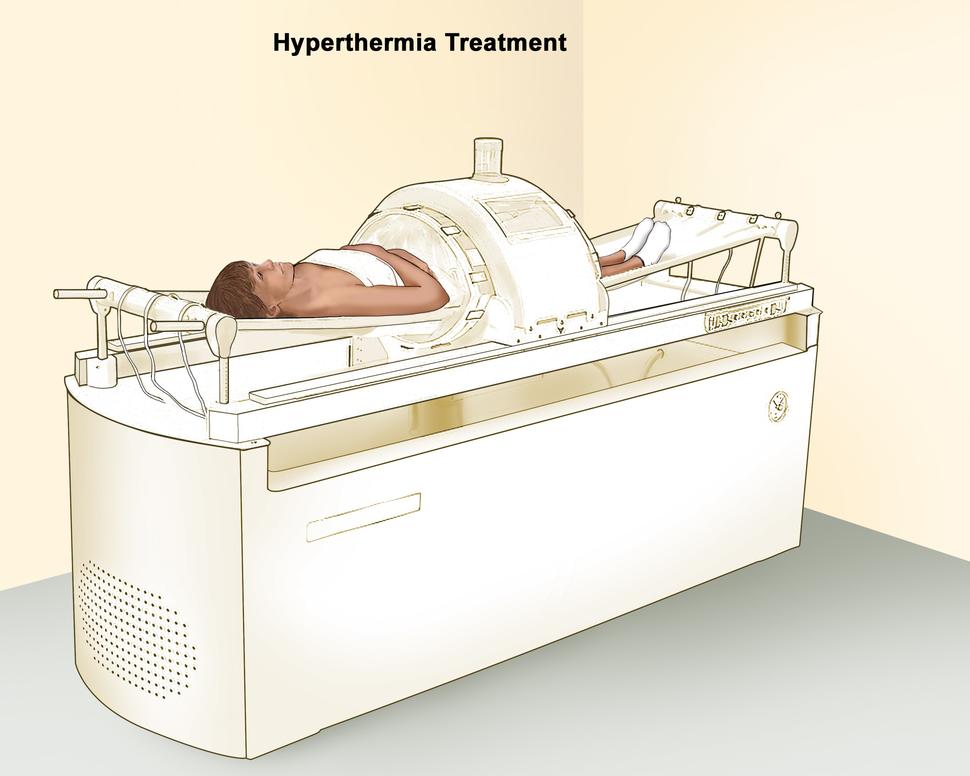What is hyperthermia treatment?
Hyperthermia is a type of treatment in which body tissue is heated to as high as 113 °F to help damage and kill cancer cells with little or no harm to normal tissue. Hyperthermia to treat cancer is also called thermal therapy, thermal ablation, or thermotherapy.
Different types of techniques may be used to create heat for hyperthermia treatment. These techniques include:
- probes that make energy from microwaves
- radio waves (also called radiofrequency)
- lasers
- ultrasound
- heating fluids such as blood or chemotherapy drugs and putting them into the body (called perfusion)
- placing the entire body in a heated chamber or hot water bath or wrapping with heated blankets
Cancers treated with hyperthermia
Hyperthermia to treat cancer is not widely available. But at some centers it is used, along with other treatments such as radiation therapy and chemotherapy, for advanced cancers. It has been used to treat these types of advanced cancers:
- appendix cancer
- bladder
- brain cancer
- breast
- cervical cancer
- esophageal cancer
- head and neck cancer
- liver
- lung cancer
- melanoma
- mesothelioma
- sarcoma
- rectal cancer
How hyperthermia treats cancer
Hyperthermia is almost always used with other forms of cancer treatment. Many clinical trials have shown that hyperthermia, when used with treatments such as radiation therapy and chemotherapy, helps shrink tumors and may make it easier for them to kill cancer cells.
How hyperthermia is given
During treatment, the doctor numbs the treatment area and inserts small probes with tiny thermometers into the tumor. Thermometers help the doctor closely watch the temperature of the tumor and nearby tissue during treatment. Imaging techniques, such as CT scans, may be used to make sure the probes are in the proper place.
Types of hyperthermia treatment
Hyperthermia can be used to treat small areas of the body, large areas, or the entire body.
In local hyperthermia, doctors apply heat to a small area. The type of local hyperthermia used depends on where the tumor is located.
- External hyperthermia is used to treat tumors that are on or just below the skin. For this type of hyperthermia, doctors place devices that create heat around or near the treatment area.
- Intraluminal or endocavitary hyperthermia is used to treat tumors within or near body cavities, such as the esophagus or rectum. In this type of hyperthermia, doctors place probes that create heat inside the cavity and insert them into the tumor.
- Interstitial hyperthermia is used to treat tumors deep within the body, such as in the brain. This type of hyperthermia allows the tumor to be heated to higher temperatures than external techniques. The doctor will insert probes or needles into your tumor while you are under anesthesia. Imaging techniques, such as ultrasound, may be used to help make sure the probe is in the right place. The heat source is then inserted into the probe.
Radiofrequency ablation is a type of interstitial hyperthermia that uses radio waves to heat and kill cancer cells.
In regional hyperthermia, doctors apply heat to large areas of the body, such as a cavity, organ, or limb. Techniques used in regional hyperthermia include deep tissue techniques, regional perfusion, and continuous hyperthermic peritoneal perfusion.
- Deep tissue techniques treat cancers within the body, such as cervical or bladder cancer. During this procedure, devices that deliver heat are placed around the cavity or organ to be treated and energy is focused on the area to raise its temperature.
- Regional perfusion techniques treat cancers in the arms and legs, such as melanoma, or in some organs, such as the liver or lung. During this procedure, some of your blood is removed, heated, and then pumped back into the limb or organ. Chemotherapy is often given during this treatment.
- Continuous hyperthermic peritoneal perfusion treats cancer within the peritoneal cavity, which is the space within the abdomen that contains the intestines, stomach, and liver.
This treatment is given during surgery. While you are under anesthesia, heated chemotherapy drugs flow from a warming device through your peritoneal cavity, causing the temperature in the area to reach 106 to 108°F.
Whole-body hyperthermia treats cancer that has spread throughout the body. In this type of hyperthermia, you are placed in a thermal chamber or wrapped in hot water blankets that raise your body temperature to 107 or 108 °F for short periods of time.
Benefits of hyperthermia
Hyperthermia can help other cancer treatments, such as chemotherapy and radiation therapy, work better.
Drawbacks of hyperthermia to treat cancer
Treatment with hyperthermia requires special equipment and expertise and is not widely available. It is also not clear if it helps people live longer.
Hyperthermia side effects
Most healthy tissue is not damaged during hyperthermia if the temperature stays under 111°F. But different features of different tissues may cause higher temperatures to occur in certain spots. This can cause burns, blisters, discomfort, or pain.
Perfusion techniques can cause swelling, blood clots, bleeding, and other damage to the normal tissues in the treated area. But most of these side effects improve after treatment.
Diarrhea, nausea, and vomiting are common after whole-body hyperthermia. It can also cause more serious side effects that are not common, including heart and blood vessel problems.
Where to go for hyperthermia treatment
A small number of hospitals and cancer centers throughout the country have skilled doctors and the machines needed to perform hyperthermia. Talk with your doctor or contact hospitals and cancer centers in your area to find out if they are using hyperthermia.
Hyperthermia treatment research
In clinical trials, doctors are studying how effective hyperthermia is for treating different cancers and when used with other cancer treatments. Other trials focus on improving techniques for delivering hyperthermia. If you are interested in joining a research study that is testing hyperthermia. Search for research studies by using the advanced clinical trials search form or contact NCI's Cancer Information Service.

